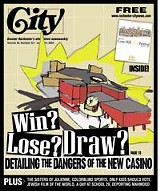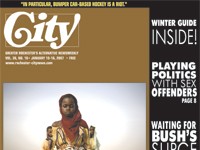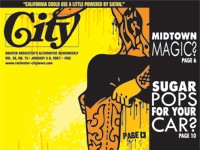[
{
"name": "500x250 Ad",
"insertPoint": "5",
"component": "15667920",
"parentWrapperClass": "",
"requiredCountToDisplay": "1"
}
]
Mall magnate Tom Wilmot made his proposal for a downtown Rochester casino official last week, in an article published by the Democrat and Chronicle. And tucked away amidst the glitzy renderings of a drastically altered Main Street was an independent assessment of the casino's social and economic impact. Prepared by the Center for Governmental Research, it's the most revealing and important discussion of the Rochester casino to date.
The report was commissioned by Wilmot's company, Wilmorite, and it generally concludes that a casino could have a positive economic impact in Rochester.
But the study also makes it clear that any economic benefits of bringing a casino to town will be achieved only if certain conditions are met. Some of those conditions could be covered in a compact made between the State of New York and the Seneca-Cayuga Tribe of Oklahoma. And apparently that compact would have to be approved by the state Assembly and Senate.
But other conditions will be dependent on the success of the Rochester casino, and on its competition from casinos elsewhere in Western New York. The CGR study contains some other warnings: existing downtown hotels could be hurt. So could downtown restaurants and bars. So could other entertainment providers. And that could cause property values in other parts of downtown to drop. (The report did not study the impact of the casino on downtown housing.)
Rochester and New York State governments could benefit from the casino deal. If the compact between the Seneca-Cayuga Tribe and the state is similar to those already drawn between New York and the Seneca Nation (a separate entity from the Seneca-Cayuga Tribe), the state will insist that it receive a portion of the casino's earnings, and it will share that money with the City of Rochester. CGR estimates additional annual city revenue at $11 million, and state revenue at $23 million. But, as we detail below, those numbers are squishy, and will ultimately be determined by the compact.
And what about the economy? CGR says that a downtown casino would increase local employment, particularly in entry-level jobs. It would stem the flow of those jobs to the suburbs. It would offer opportunities for people looking to get off welfare. It could make Rochester more attractive for conventions. It would bring back some Rochester-area residents who now go to casinos in the Niagara Falls and Syracuse areas. It would bring new uses to two important downtown sites: the Sibley Building and the Midtown Plaza property.
In addition, CGR estimates that the casino's "indirect" economic impact --- money spent by casino employees or the casino itself --- will generate nearly 500 new jobs and a payroll of just under $15 million.
The potential for the positive effects of the casino has received much of the focus of recent news reports. The negatives have not, however. The time for considering those negatives --- by the public, and by state legislators --- is now. Once the Seneca-Cayuga Tribe is granted a slice of sovereign land in the heart of downtown, all bets are off.
The primary goal of the CGR report is to determine approximately how much money the casino will add to the local economy. After the winning gamblers get their take, how much will be left?
The CGR report makes it clear that projections of the casino's economic impact are tenuous. Wilmorite projects a $350 million "net win," or economic benefit, for Rochester. The CGR report says that estimate is "at the high end of the probable range." It adds: "While we believe this estimate to be optimistic, it is not outside the range of market penetration for other markets in the United States."
But the report qualifies that $350 million. The figure includes $117 million that Wilmorite says will be gained from casino customers who live within its 50-mile radius. That revenue isn't "new," says the report, because "these dollars are already in the Rochester economy and either being spent on other goods and services or are being saved."
CGR estimates that another $12 million would be simply moved from one venue to another --- spent at the casino instead of the Finger Lakes Racetrack or at existing local bingo operations, for example.
So CGR concludes that a Rochester casino would boost the local economy's output by $221 million, not $350 million. This figure includes any portion of the casino's payroll that would be new to the local economy.
Wilmorite is estimating that in its second year, the casino would employ almost 1,300 people and that its payroll would be about $48 million. But nearly a third of those jobs, says CGR, would be "displaced from other parts of the economy." CGR estimates that the casino would create the equivalent of 800 new fulltime jobs, and a net new payroll of $31 million.
More troubling: even after these reductions, the $221 million doesn't account for the possibility that other new casinos will open in Western New York. The Seneca Nation, which already operates casinos in Niagara Falls, New York; Salamanca, and Irving (in Chautauqua County), is planning yet another casino, in Buffalo or Cheektowaga.
If the Seneca Nation built another casino in Western New York, says the CGR study, "total revenue to a Rochester casino would fall."
In fact, casino development in Western New York and nearby Ontario Province, Canada, has exploded. The Oneida Nation's Turning Stone, east of Syracuse, opened in 1993. It's now in the midst of a major expansion. Casino Niagara in Niagara Falls, Ontario, opened in 1996. The more upscale Niagara Fallsview opened in the same city last month.
And the Seneca-Cayuga Tribe itself is considering opening a casino in Auburn, just 70 miles west of Rochester.
"Recent and proposed additions to the western New York market will move the market toward saturation," says the CGR study. With the Rochester casino, CGR estimates that Western New York would have 20,402 gaming "positions" (slot machines, seats at gaming tables, etc.). That equals roughly one gambling position for every 131 people in the region. Compare this to Detroit, Michigan, with 9,933 positions --- one for every 715 people in the Detroit market.
A large component of the Wilmorite plan, according to the Democrat and Chronicle's report, is a 400-room hotel in the tower adjacent to the former Sibley's department store. But CGR says most of the people who would go to the Rochester casino, as defined in the Wilmorite plan, would be from a 50-mile radius. The casino isn't likely to attract overnight gamblers. There are too many more impressive casinos to choose from.
True high-rollers, and people looking for a casino-oriented vacation, will prefer Las Vegas or large-scale gaming operations on the east coast like Foxwoods in Connecticut. Even regional players looking to spend a couple of nights will have better options: Turning Stone has three golf courses, and its $308 million expansion will increase its hotel offerings. Fallsview in Niagara Falls, Ontario, offers views of the Canadian Horseshoe Falls.
The CGR report follows certain assumptions based on information gathered by Palermo Gaming Resort Development, a California firm also hired by Wilmorite as a consultant.
According to CGR, "the market study conducted by Palermo Gaming & Resort Development does not forecast a significant increase in overnight visitation as a result of the construction of the casino. Additional lodging capacity incorporated into the casino would very likely increase vacancy rates among existing facilities and reduce hotel and motel tax receipts."
That isn't good news for downtown hotels, which have been suffering from a high vacancy rate and ownership changes. A hotel located on the same site as a casino could very well succeed, but unless the casino drew new overnight visitors to Rochester, it could simply pull guests out of the Hyatt, the Clarion Hotel Riverside, and the Crowne Plaza.
Area hotels aren't the only businesses that would be greatly affected by a Rochester casino. "Economic benefits may be highly concentrated at the casino site," says CGR.
The Wilmorite plan includes restaurants and bars. The East End and Alexander Street areas have become a downtown success story, drawing huge numbers of people to their restaurants, bars, and nightclubs. What can those businesses expect if a casino moves down the street and offers similar amenities?
CGR analyzed a study of 100 communities with and without casinos, conducted by the National Opinion Research Center of the University of Chicago. The results were mixed. The unemployment rate in communities with casinos was lower, as was residents' need for welfare assistance. "Private earnings in construction, hotels and lodging, and recreation and amusement" rise, says the CGR report.
But the earnings for restaurants and bars fell --- by 19 percent, says the CGR study. That statistic is significant, because the population of Rochester area is stagnant. And some restaurants in the Rochester area are already struggling.
"It has been widely observed in other communities with casinos that the health of neighboring food, drink, and retail is endangered by the facilities located within the casino," says the CGR study.
The jobs themselves would not necessarily be lost, says the study. They would simply move from the other downtown businesses into the casino. But if the Rochester casino includes restaurants, bar, and retail stores, "existing downtown food, drink, and retail establishments are likely to suffer a loss of business," says CGR.
And, says CGR, "the consequences for downtown are broader" if problems with those businesses have a "cascading impact," causing downtown property values and rental rates to decline.
"Furthermore," says the CGR study, "the benefit of addressing blight at Sibley and Midtown would be partially undone by shifting the blight to business locations now viable."
Then there are the questions about the money the state and city would get.
In the compacts between the Seneca Nation and the state, New York receives a specific share --- 18 to 25 percent --- of the casino's revenue after it pays out gamblers' winnings.
But those compacts place a minimum, not a limit, on what the casinos can offer as winnings.
"The minimum payout at Indian-run casinos" can be more than 90 percent of a casino's earnings, says CGR. As Western New York gets more and more saturated with Indian-run casinos, competition will get stiffer. And raising winnings percentages is a common way to attract more customers.
"Some casinos promote so-called 'high stakes' slot machines with payouts of 98 percent," says the report.
So any forecasts made about how much money the state and city will receive will be dependent largely upon the market. If competition continues to heat up, the amount of money shared with the state could shrink. And as the CGR report states, Western New York is nearly saturated with Indian-run casinos.
In its compact with the Seneca-Cayuga Tribe, the state could impose a limit on the payoff percentage. Video Lottery Terminals (VLTs) in New York's racinos, for example, must issue no more than 90 percent of their take as winnings. A similar limitation would help prevent the casino from lowering the state's take. But the casino's revenue itself --- and thus the state's revenue --- would still depend on the number of people who go to the casino. And that could be adversely affected by increased competition from other casinos in the region. And some of them would have no limits on winners' payoff.
For the City of Rochester, the casino poses a dilemma. The CGR study estimates that the city could gain $11 million. But CGR also estimates that the burden from social costs --- problem gambling, for example --- could amount to $10 million. CGR notes that the city wouldn't have to bear those costs alone; they would be shared by other governments and by non-profit social-service agencies. But county government is already struggling to reduce its social-service costs; it's questionable whether the county would be willing to shoulder new costs. And area non-profits have budget problems of their own.
For the cash-strapped state, however, a Rochester casino deal may be a no-brainer. It has the choice of gaining $23 million a year in revenue or coming up with hundreds of millions out of its budget to settle its land-claim disputes.
Governor George Pataki has been quoted as saying Rochester won't get a casino if it doesn't want one. And Mayor Bill Johnson and City Council President Lois Giess have been clear about their opposition to the project.
But how will Pataki measure "the community"?
The casino is already gaining support from important local business leaders and some politicians. Will that be enough to give Pataki the green light?
Casino background
News that Rochester could become home to a downtown casino began surfacing several months ago, with reports that the local commercial real-estate development firm Wilmorite had begun bankrolling the Seneca-Cayuga Tribe of Oklahoma, which is in the midst of a land-claim dispute with New York State. Wilmorite owns several area suburban malls like Eastview. It also owns the Sibley Building, and owes the city more than $13 million in taxes, delinquent loans, and late fees on that property.
The Seneca-Cayuga Tribe wants to replace Midtown Plaza with a casino and put a hotel and gambling facilities across Main Street in and around the Sibley Building, effectively removing both properties from the tax rolls. As part of the deal, the tribe would also build a 2,800-seat performing arts center.
If Governor George Pataki reaches a settlement agreement with the tribe and it's approved by Congress and the State Legislature, the tribe could effectively embark on a private real-estate transaction with the owners of Midtown and Sibley.
Your voice
Do you want a casino in downtown Rochester? Do you want more information, and more time to learn about the issue?
Should the governor of New York, and the governor alone, be able to decide whether the casino will be built?
If you're concerned, speak up. Write to Pataki and to area state legislators. Write to County Executive Maggie Brooks. Tell her to insist, on your behalf, that the project be brought out into daylight.
Here's the address list:
County Executive Maggie Brooks, 110 County Office Building, 39 West Main Street, Rochester 14614-1476
Mayor Bill Johnson, City Hall, 30 Church Street, Rochester, 14614.
City Council President Lois Giess, City Hall, 30 Church Street, Rochester, 14614.
Governor George Pataki, Executive Chamber, State Capitol, Albany, New York 12224.
Senator Michael Nozzolio, 119 Fall Street, Seneca Falls 13148.
Senator James Alesi, 220 Packett's Landing, Fairport 14450.
Senator Joseph Robach, 2300 West Ridge Road, Rochester 14626.
Senator George Maziarz, 350 New Campus Drive, Brockport 14420.
Assemblymember Joseph Errigo, 3045 East Henrietta Road, Henrietta 14467.
Assemblymember Susan John, 840 University Avenue, Rochester 14607.
Assemblymember Joseph Morelle, 1945 East Ridge Road, Rochester 14622.
Assemblymember David Gantt, 74 University Avenue, Rochester 14605.
Assemblymember William Reilich, 2300 West Ridge Road, Rochester 14626.
Assemblymember David Koon, 268 Fairport Village Landing, Fairport 14450.
Assemblymember Charles Nesbitt, 121 North Main Street, Albion 14411.
Speaking of...
-
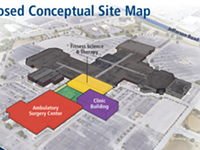
URMC plans orthopedic campus at Marketplace Mall
Nov 20, 2019 -
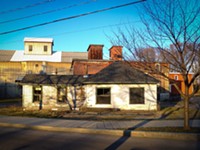
Wilmorite withdraws Pittsford hotel proposal
Feb 5, 2018 -

CGR updates child care subsidy report
May 11, 2015 - More »
Latest in Featured story
More by Chad Oliveiri
-

Fiz - 1.11.06
Jan 11, 2006 -
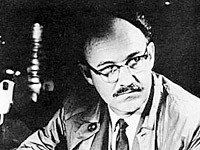
Final cut pro
Nov 16, 2005 -
It’s the economy, stupid
Jul 27, 2005 - More »
